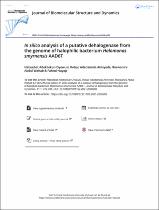In silico analysis of a putative dehalogenase from the genome of halophilic bacterium Halomonas smyrnensis AAD6T
Date
2022Author
Oyewusi, Habeebat Adekilekun
Akinyende, Kolajo Adedamola
Wahab, Roswanira Abdul
Metadata
Show full item recordAbstract
Microbial-assisted removal of natural or synthetic pollutants is the prevailing green, low-cost technology
to treat polluted environments. However, the challenge with enzyme-assisted bioremediation is
the laborious nature of dehalogenase-producing microorganisms’ bioprospecting. This bottleneck
could be circumvented by in-silico analysis of certain microorganisms’ whole-genome sequences to predict
their protein functions and enzyme versatility for improved biotechnological applications. Herein,
this study performed structural analysis on a dehalogenase (DehHsAAD6) from the genome of
Halomonas smyrnensis AAD6 by molecular docking and molecular dynamic (MD) simulations. Other
bioinformatics tools were also employed to identify substrate preference (haloacids and haloacetates)
of the DehHsAAD6. The DehHsAAD6 preferentially degraded haloacids and haloacetates ( 3.2–4.8 kcal/
mol) and which formed three hydrogen bonds with Tyr12, Lys46, and Asp182. MD simulations data
revealed the higher stability of DehHsAAD6-haloacid- (RMSD 0.22–0.3 nm) and DehHsAAD6-haloacetates
(RMSF 0.05–0.14nm) complexes, with the DehHsAAD6-L-2CP complex being the most stable. The detail
of molecular docking calculations ranked complexes with the lowest binding free energies as:
DehHsAAD6-L-2CP complex ( 4.8 kcal/mol) ¼ DehHsAAD6-MCA ( 4.8 kcal/mol) < DehHsAAD6-TCA
( 4.5 kcal/mol) < DehHsAAD6-2,3-DCP ( 4.1 kcal/mol) < DehHsAAD6-D-2CP ( 3.9 kcal/mol) <
DehHsAAD6-2,2-DCP ( 3.5 kcal/mol) < DehHsAAD6-3CP ( 3.2 kcal/mol). In a nutshell, the study findings
offer valuable perceptions into the elucidation of possible reaction mechanisms of dehalogenases for
extended substrate specificity and higher catalytic activity.

